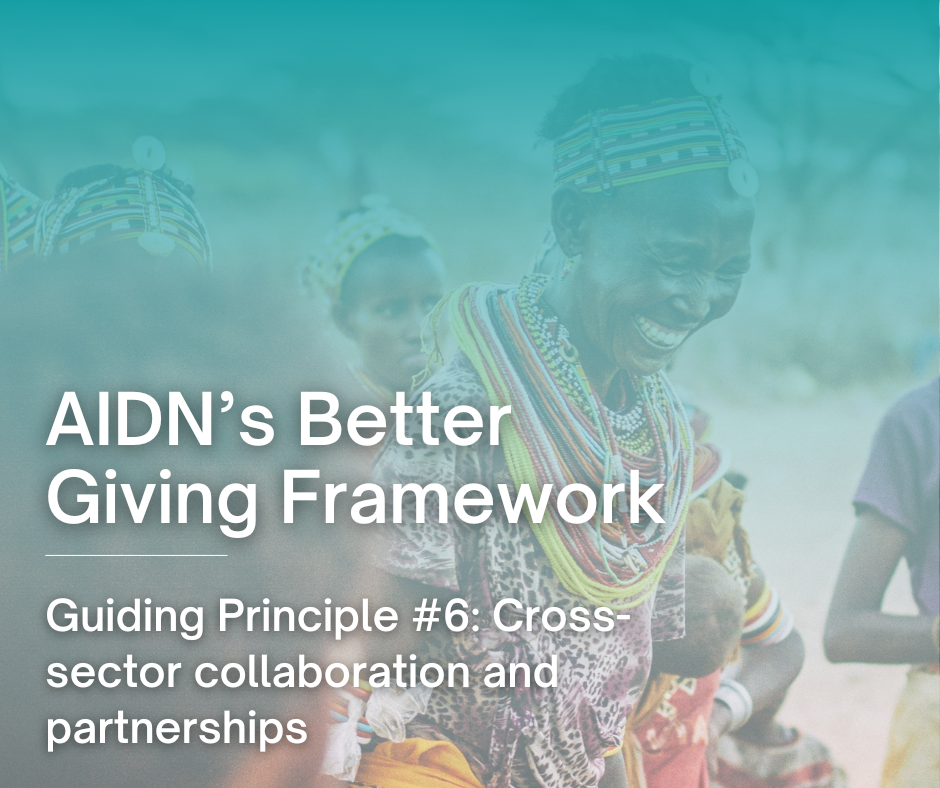AIDN’s Better Giving Framework is a key resource for funders that shares what we believe, and what our network has helped us to understand, are the key principles that underpin “better” giving and investing in today’s international development sector. The sixth Guiding Principle of our Better Giving Framework is: “Cross-sector collaboration and partnerships”. Read below to learn more about and access detailed resources on Guiding Principle #6.
And finally, AIDN believes that funders should reflect on the worth of cross-sector collaboration when giving or investing in international causes. This approach means considering how international development organisations or programs may engage with all levels of the system – from community-level service delivery, through subnational government structures, to the private sector, to national policies and ODA budget allocations – and how this may ultimately change the impact of a program.
AIDN appreciates that fostering cross-sector collaborations is an ambitious task. There can be power imbalances, funding inequalities and organisations working in different sectors also have different goals and objectives. For some critics, cross-sector collaborations can also dilute the process and mean programs ultimately risk having little immediate impact. Nevertheless, there are several reasons why it is important for funders to take this wider systems view.
First, engaging with other types of funders and/or sectors can add to the overall pool of money going to important causes. A core part of AIDN’s mission is to foster discussion on the future of innovative development financing in Australia, including impact investing, blended finance, private-public partnerships or even public-private-philanthropic partnerships. In this context, AIDN welcomed the Australian Government’s Development Finance Review in 2023 that included a new focus on blended and climate finance, and the requirement that new development finance investments must incorporate a stronger focus on gender, disability, social inclusion, or First Nations peoples.
Second, cross-sector collaboration brings together diverse mind-sets, skills, frameworks and approaches to create appropriate solutions to complex problems. For example, grassroots organisations often contribute deep local knowledge that informs both program delivery and policy advice. International NGOs, such as UNICEF or Plan International, then connect with these organisations to support scale-up and replication, or foster policy advocacy. Think tanks and government can translate successful community-level initiatives into national policies backed by public funding.
In fact, this ethos underscored the creation of the Cross Sector Development Partnerships Initiative (XPSI) in 2020. XPSI provides a platform for establishing new partnerships, identifying projects and bringing together cross-sector stakeholders among Australia’s business, government, NGO/NFP, academia/health/medical research and philanthropy/private capital stakeholder sectors to support the SDGs and country development plans. Other examples include the Village HIVE model in Cambodia or Global Vaccine Distribution (COVAX) – that brought together governments, NGOs, pharmaceutical companies, and international organisations to ensure equitable access to COVID-19 vaccines.
Fourth and finally, cross-sector collaboration puts all forms of giving (including philanthropic, private or ODA) into wider political, economic and cultural contexts (or a “systems strengthening approach”) – which makes it easier to create or understand impact. For example, when funders understand philanthropic giving (such as: funding women’s access to reproductive health education) as one part of a wider system of funding alongside other sectors (such as: concurrent government funding for women’s hospitals), funders may better understand how their grant might have greater impact or is part of wider systemic change in the target community.
For more resources on cross-sector partnerships:
- “AIDN’s Better Giving Framework Webinar #3: Partner for the long-term (but also plan for sustainable “graduation”)” featuring Andy Bryant, Audette Exel AO, Weh Yeoh and Gayle Deighton.
- “Cross-sector partnerships: 5 years of lessons from Bangladesh“ by Jessica Carter for The AIDN Beat 2025
- “The role of the private sector in achieving the SDGs” webinar from Charities Aid Foundation and UN Sustainable Finance Hub 2023
- “At the intersection: on building trust through cross-sector collaboration between the public, nonprofit, and private sectors” by Daniel P. Gittermna, Neil Britto, Sonal Shah and Zia Khan for Stanford Social Innovation Review 2021
- “The growing role of the private sector in developing co-operation: challenges for global governance” by Andre de Mello e Souza for OECD Development Matters
- “The role of public-private-philanthropic partnerships in driving climate and nature transitions” report from McKinsey Sustainability 2023
- “Achieving the SDGs means investing in MSMEs” by Cameron Neil (LendForGood) for The AIDN Beat 2023
- “Impact Investment in Bangladesh: A new story” by Nick Goryl and Lily Van Berkel (XSPI) for The AIDN Beat 2024
- “The social activist who learnt lessons in power and capital so she could affect change” – AIDN’s Philanthropod 2023 with Audette Excel, Founder and CEO of Adara Group
- “Activating potential: catalysing social entrepreneurs to alleviate poverty with D-Prize” – AIDN’s Philanthropod 2023 with Nick Fusso, co-founder of D-Prize
